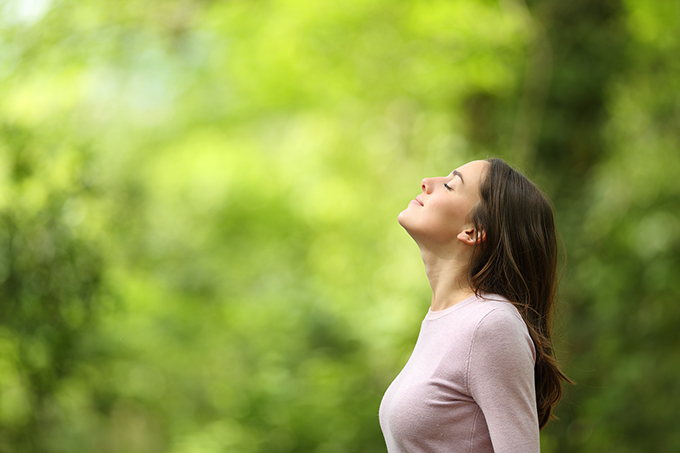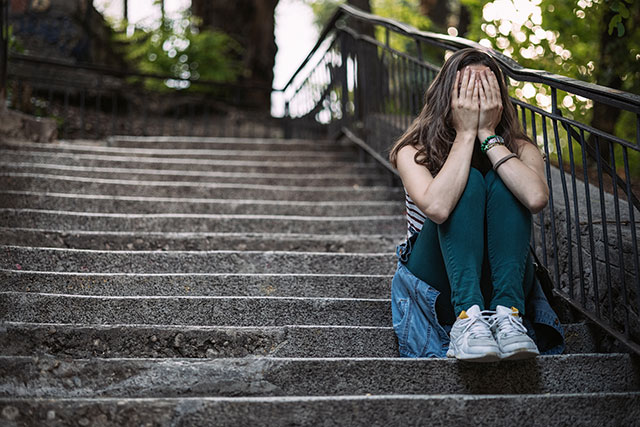Mindfulness, in its most basic form, is being fully present, aware of where you are and what you are doing. Mindfulness is paying attention to your thoughts and feelings and accepting them. Read on to understand more about mindfulness and learn mindfulness of breath exercises.
Mindfulness meaning
Mindfulness is a practice that involves focusing your attention on the present moment. This means setting aside your worries about the past or future and concentrating on what’s happening right now.
Mindfulness is about becoming aware of your thoughts, feelings, body sensations, and the environment around you without judgment. The goal is to create a sense of curiosity and openness to your present experience. Unlike daydreaming or getting lost in thought, mindfulness encourages you to be fully engaged in the here and now.
It can be fairly easy to try a mindfulness technique, and like most things, the more we practise, the better we get at it.
If you’re concerned about a health issue or whether mindfulness is safe for you, please contact your health professional first.
Mindfulness benefits
Researchers have been looking into the benefits of mindfulness over the years. Here are some of the ways practising mindfulness can benefit your mental health and wellbeing:
Reduce stress and anxiety – Researchers reviewed 200 mindfulness studies and found that mindfulness can be effective in reducing stress and anxiety.[1]
Reduce rumination – Studies have suggested that mindfulness may reduce rumination (continuously thinking about the same thoughts). One study reported that in addition to reducing rumination, participants also improved working memory and sustained attention.[2]
Improve concentration – A UK and German study suggests that concentration and working memory improved after doing mindfulness of breath exercises for ten minutes a day.[3]
Achieve a state of calm – By training your attention to what is happening and accepting your thoughts and feelings, you can achieve a calm state.
Improve physical health – A review of studies suggests that mindfulness interventions can be linked with positive physical health outcomes.[4] Another study suggests that mindfulness may improve daily pain and stress for people with chronic pain.[5]
Improve sleep – An American study suggests that adults who completed a mindfulness awareness program had less insomnia and fatigue.[6]
Reduce negative mental health impact of news exposure – A Canadian and American study suggests that brief daily mindfulness sessions for ten days may provide a protective buffer against the negative impact of exposure to COVID-19 news consumption, thereby reducing stress. The participants also reported to have a more positive mood.[7]
Please note that mindfulness techniques should not replace the healthcare advice you have received from your GP or other health professional.
How mindfulness works
Once you start practising mindfulness, you may notice how difficult it is to exert control over your thoughts. Thinking about anything will inevitably lead to another thought while attempting to think about ‘nothing’ will result in thoughts entering your mind.
Understanding this is one of the keys to mindfulness. When trying a mindfulness activity, you’re not trying to actively suppress thoughts. Instead, you acknowledge that thoughts will occur. However, depending on which mindfulness technique you use, you can control how you respond to those thoughts. For instance, you can gently bring your thoughts back to counting breaths or focusing on your breathing, bring your gaze back to the object of your visual focus, or focus on a specific sound.
Mindfulness of breath activities
Here are some mindfulness of breath activities you can try to get you started.
Counting your breaths
This exercise is a good place to start if you’re new to mindfulness.
- Find a relatively quiet place and sit in a comfortable position
- Close your eyes or soften your gaze and start to pay attention to your breath
- As you inhale, count 1
- As you exhale, count 2
- As you inhale, count 3
- As you exhale, count 4 and so on.
Deep breathing exercise
When you’re feeling stressed or anxious, your breathing can become short and shallow. One way to ease the stress is to do some deep breathing.
- Breathe in slowly for four seconds
- Breathe out slowly for four seconds
- Repeat the steps above four to five times.
Box breathing exercise
Box breathing (also known as square breathing) involves taking deep breaths in a sequence of 4 steps.
- Find a quiet space to sit or lie down and make yourself as comfortable as you can
- Breathe out slowly through your mouth emptying your lungs
- Breath in slowly through your nose, counting to four – be aware of how the air is filling your lungs and stomach
- Hold your breath as you count to four
- Breath out slowly counting to four – be aware of the feeling of the air leaving your lungs
- Hold your breath again as you count to four
- Repeat steps 3 to 6 two to three times or set a timer for five minutes.
If you find counting to four seconds too long, do what feels comfortable. For example, you can try the exercise counting to two seconds.
More mindfulness activities
Now that you’ve started mindfulness of breath exercises, we have a few more mindfulness techniques for you to try.
Mindful walk
Practising mindfulness doesn’t always involve being still. You can apply it while you are moving as well.
- Walk outside, such as in park or around the block.
- For the first few minutes, start by observing any physical sensations you can feel – the ground under your feet, the fresh air on your skin, the sun on your face, the clothes on your skin.
- Now, start to shift your focus to observe the sounds around you – birds tweeting, cars driving by, the sound of your footsteps, people talking on the street.
- Next, pay attention to the details you can see around you – what objects do you see? What colour, texture and shape are they?
- Now notice any smells around you – garden flowers, freshly mowed lawns
- In the final few minutes of your walk bring your attention to your steps, counting them slowly in groups of ten.
- When you are ready to finish, stop walking and pause for a moment before continuing your day.
Gratitude journal
Taking a deliberate moment to consider what we are grateful for can help slow down our thoughts and bring us back to the present moment. Carve out five to ten minutes to sit down and write a list of all the things you appreciate and try to be as specific as possible. This can also shift us from a negative mindset to a more positive one.
Set your intentions
Pausing before we take on the day to set our intentions can help us be more mindful of our actions, thoughts, and conversations throughout the day.
- Find a quiet space to sit and make yourself as comfortable as possible.
- Contemplate what matters most to you today – what can you achieve only today?
- Consider what you would like to let go of – are you holding negative thoughts you can let go of?
- Think about your values – choose the values you want to live by and project today.
- Take a few deep, slow, mindful breaths before resuming your day.
Focus on the present
This simple mindfulness activity can be done almost anywhere to help re-centre your mind and bring you to the present moment.
- Set aside 5 minutes
- Observe the present moment
- Pay attention to your senses – what can you see, smell, taste, touch or hear?
- Accept things for what they are – let your judgments roll by
- If your mind wanders, gently bring it back to the present moment.
If you find it hard to start because your mind is racing, try calmly breathing in and out to slow down your thoughts.
Mindfulness resources
Here are some mindfulness resources that you may find helpful:
Smiling Mind is a free app developed by psychologists and educators. It has mindfulness exercises that can help bring balance to your life.
This Way Up has a free online introduction to mindfulness course available.
Black Dog Institute has a mindfulness fact sheet that includes a list of books and apps.
Head to Health has resources and links to mental health providers – type in mindfulness in the search bar to access information.
Mindfulness is not for everyone. If you’re still feeling stressed and anxious, you can reach out for help. Our SuicideLine Victoria counsellors are here 24/7 on 1300 651 251, or you can speak to your GP or health professional for advice.
If you are struggling, speak to one our SuicideLine Victoria counsellors on 1300 651 251 or you can click on the floating chat button on the right to start a web chat.
If it is an emergency, call 000.
References
[1] Mindfulness-Based Therapy: A Comprehensive Meta-Analysis Khoury, B., et. al. Clinical Psychology Review, 2013. https://doi.org/10.1016/j.cpr.2013.05.005.
[2] Chambers, Richard & Lo, Barbara & Allen, Nicholas. (2008). The Impact of Intensive Mindfulness Training on Attentional Control, Cognitive Style, and Affect. Cognitive Therapy and Research. 32. 303-322. 10.1007/s10608-007-9119-0.
[3] Schöne, B., Gruber, T., Graetz, S. et al. Mindful breath awareness meditation facilitates efficiency gains in brain networks: A steady-state visually evoked potentials study. Sci Rep 8, 13687 (2018). https://doi.org/10.1038/s41598-018-32046-5
[4] Creswell, J. David PhD; Lindsay, Emily K. PhD; Villalba, Daniella K. PhD; Chin, Brian MA Mindfulness Training and Physical Health: Mechanisms and Outcomes, Psychosomatic Medicine: April 2019 – Volume 81 – Issue 3 – p 224-232 doi: 10.1097/PSY.0000000000000675
[5] Davis, M. C., Zautra, A. J., Wolf, L. D., Tennen, H., & Yeung, E. W. (2015). Mindfulness and cognitive–behavioral interventions for chronic pain: Differential effects on daily pain reactivity and stress reactivity. Journal of Consulting and Clinical Psychology, 83(1), 24–35. https://doi.org/10.1037/a0038200
[6] Black DS, O’Reilly GA, Olmstead R, Breen EC, Irwin MR. Mindfulness Meditation and Improvement in Sleep Quality and Daytime Impairment Among Older Adults With Sleep Disturbances: A Randomized Clinical Trial. JAMA Intern Med. 2015;175(4):494–501. doi:10.1001/jamainternmed.2014.8081
[7] Kam, J.W.Y., Javed, J., Hart, C.M. et al. Daily mindfulness training reduces negative impact of COVID-19 news exposure on affective well-being. Psychological Research (2021). https://doi.org/10.1007/s00426-021-01550-1









